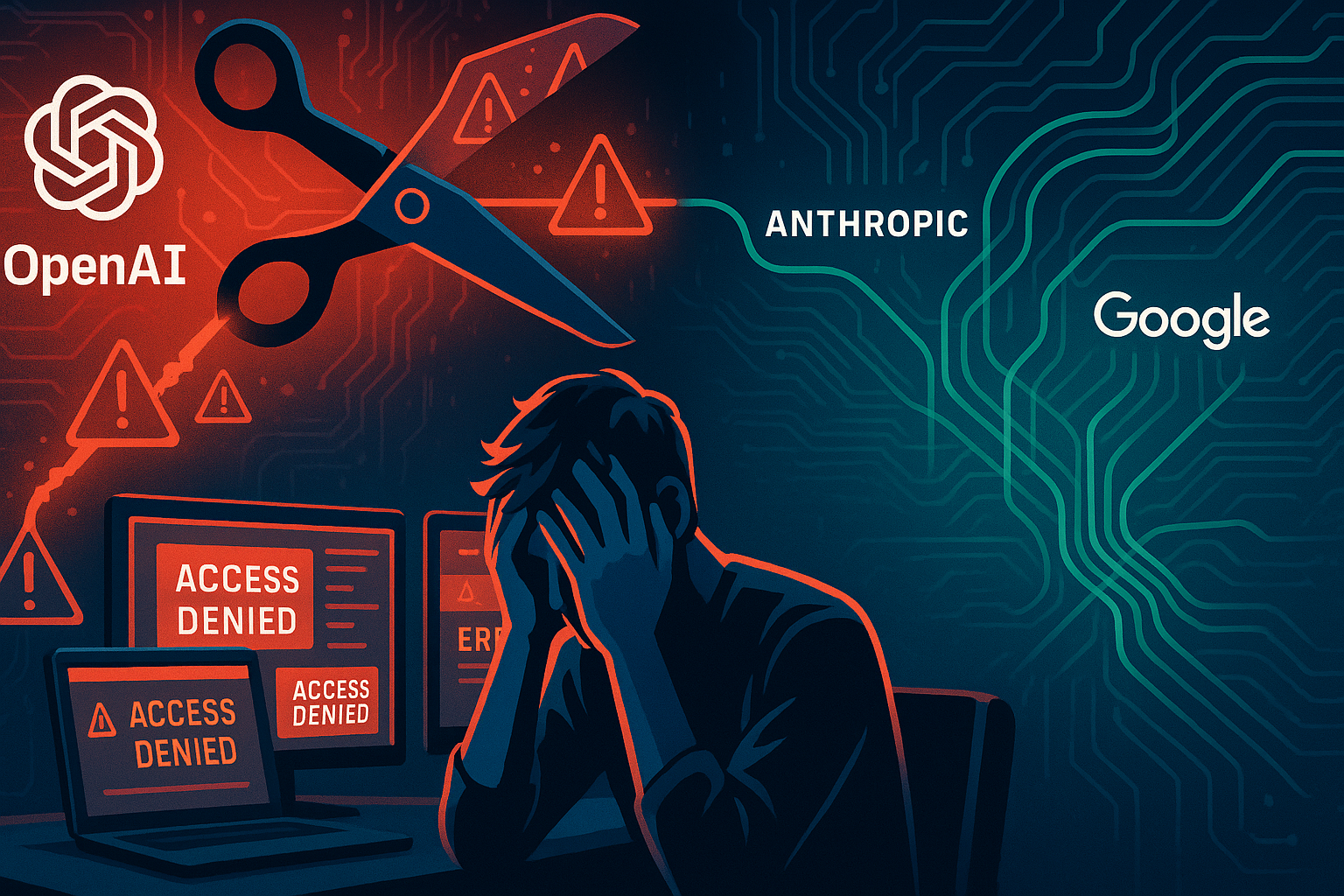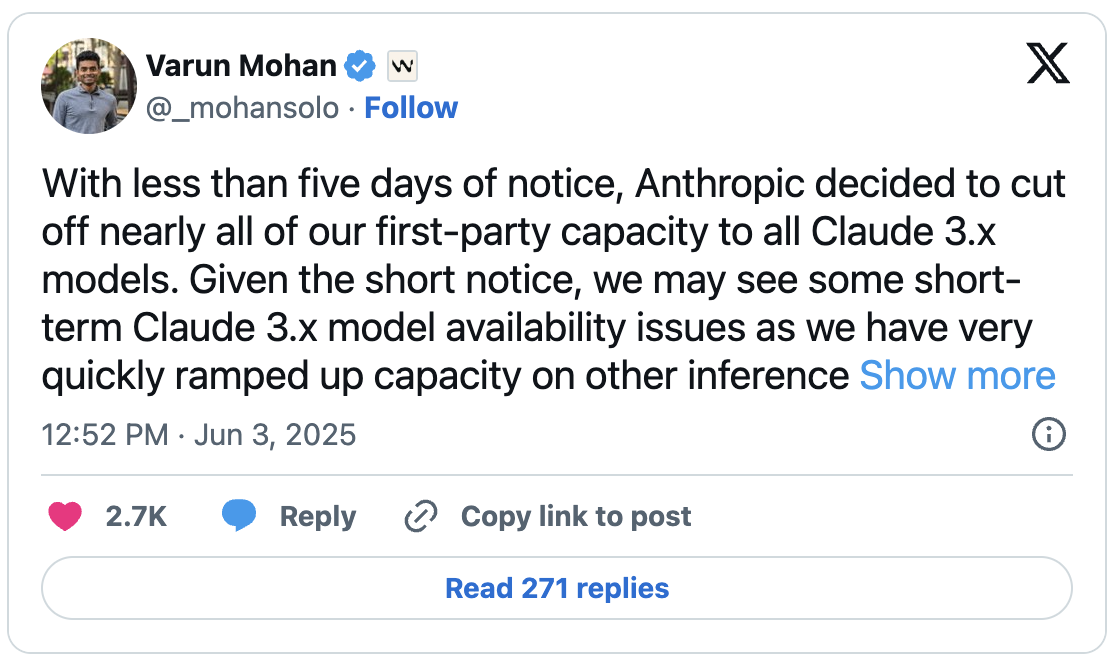About two weeks ago, Anthropic suddenly cut off Windsurf’s access to Claude models with less than five days’ notice, leaving over one million developers scrambling. The reason? Anthropic’s co-founder bluntly said they found it “odd” to sell Claude access to what would soon become OpenAI’s property through a $3 billion acquisition.
If you’re building anything that depends on a single AI provider, this should terrify you.
The Windsurf Disaster Shows What’s Coming

The fallout was immediate. Free tier users got cut off completely. Trial users? Same story. Multiple developers publicly announced they were jumping ship to other platforms.
Here’s what really gets me: despite Windsurf’s willingness to pay full price, Anthropic prioritized “sustainable partnerships”, corporate speak for “we don’t want to help our competitors.” This wasn’t about capacity. This was pure business strategy, and developers paid the price.
Windsurf CEO Varun Mohan’s tweet captured the frustration perfectly:
 Windsurf CEO Varun Mohan breaks the news to over 1 million developers on X - Source
Windsurf CEO Varun Mohan breaks the news to over 1 million developers on X - Source
The tweet got 2.7K likes and 271 replies, mostly from angry developers who suddenly found themselves caught in the crossfire of corporate politics.
This Is The New Normal
Platform risk in AI is escalating fast. What used to be 60-90 day deprecation notices are now becoming 5-7 days for “competitive reasons.”
Remember Twitter’s 2023 API shock? Overnight pricing went from free to $40,000+ monthly, destroying research projects and forcing organizations to abandon years of work.
OpenAI killed Codex in March 2023 with less than a week’s notice, forcing platforms to scramble and users to face performance drops.
The pattern is clear: strategic business decisions drive these restrictions. Technical reasons are just convenient cover stories.
What AI Platform Risk Actually Costs Your Business (And How Multi-Model Saves You)

Let’s talk real numbers. When platform dependency bites you, here’s what you’re actually looking at:
Development delays: 3-6 months of stalled projects during forced migrations while your competitors keep shipping
Team productivity loss: 40% drop in output as developers learn new tools, rebuild integrations, and troubleshoot compatibility issues
Financial exposure: If you’re spending $200K annually on AI tools, single-provider dependency puts $50-100K at risk during forced migrations, plus 2-4 weeks of team downtime
Strategic paralysis: Board-level questions about your technology choices when you can’t deliver on commitments because a vendor changed their mind
This isn’t just an IT problem, it’s a business continuity crisis waiting to happen.
Here’s the kicker: organizations using multi-model AI strategies report 40-60% cost savings through smart task routing, plus 25-40% better contract terms because vendors know you’re not trapped.
And this is because different models excel at different things:
| Model | Best For |
|---|---|
| GPT-4 | Complex reasoning, analysis |
| Claude | Technical tasks, code |
| Gemini | Writing, nuanced content |
| Local models | Privacy, basic tasks |
Your mileage may vary. Side effects may include: arguing with other developers about model preferences, obsessively benchmarking everything, and developing strong opinions about which AI writes the best poetry. Consult your local tech lead before switching models.
Instead of forcing one model to do everything, you route tasks where they’ll be handled most efficiently. It’s like having a toolbox instead of trying to hammer every nail with a screwdriver.
Smart Platforms Learned This Early
Smart platforms like GitHub Copilot and Tabnine learned this lesson early and built multi-provider capabilities from the start. But most developers are still trapped in single-provider setups, waiting for the next platform apocalypse to hit them.
The writing’s on the wall: enterprise customers increasingly demand multi-provider capabilities as baseline requirements. If you’re not building with this flexibility, you’re building on borrowed time.
The Smart Alternative to Platform Russian Roulette
Sure, you could try to build your own multi-provider architecture. You’d need to:
- Manage multiple vendor relationships, contracts, and billing
- Build custom routing logic and failover systems
- Maintain security compliance across multiple providers
- Monitor performance and costs across platforms
- Handle integration complexity and API differences
Or you could eliminate the platform risk without the operational nightmare.
Wink wink, nudge nudge - there’s a reason we built Nimblebrain.
Your Move: Diversify or Get Disrupted
Platform risk in AI isn’t theoretical anymore, it’s operational reality. The Windsurf incident proved that even willing-to-pay customers get cut off when business strategy shifts.
Smart CTOs are already moving:
- Auditing AI dependencies before they become liabilities
- Building multi-provider capabilities through platforms like Nimblebrain
- Capturing 40-60% cost savings while eliminating vendor lock-in
The window for proactive planning is closing. Don’t be the CTO explaining to your CEO why your AI strategy got torpedoed by vendor politics.
Ready to eliminate your AI vendor lock-in? Email us at hello@nimblebrain.ai - your future self will thank you.